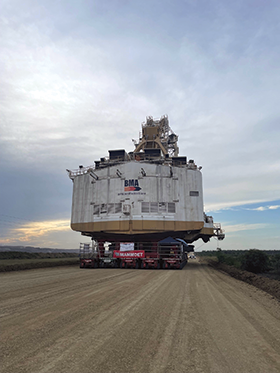
Draglines are key pieces of equipment in open-pit mining. These excavation giants are big, heavy and powerful, making them challenging to move. Designed to operate on one mine site, with an inability to travel long distances efficiently under their own steam, these massive, electric mining machines require a lot of ancillary transmission and generation equipment to move between dig sites.

BHP Mitsubishi Alliance (BMA) entrusted Mammoet with the relocation of a 3100 ton Marion 8050 dragline from one end of the Peak Downs coal mine in Queensland, Australia to another − a full 27 km away.
With a deadline to achieve the relocation, it was sub-optimal to allow the dragline to travel under its own steam. The solution was to jack up the dragline so it could be carried by Mammoet self-propelled modular transporters (SPMTs). These can travel up to 5 km per hour. In comparison, a dragline can cover approximately 1 km in 12 hours.
This approach was taken once before by Mammoet in Australia back in 2017, also with BMA. This time however, failure to reach and cross a rail line by a certain deadline resulted in considerable downtime and cost to the project. What’s more, with extra equipment needed to complete the job and all imports subject to strict customs requirements, Mammoet needed to call on its global expertise and fleet to ensure smooth execution.
Jacking and carrying a 3000 ton dragline
Eight JS500 towers were set up underneath the dragline for the jacking operation. Once it was elevated to 2,5 metres, a configuration of 5x28 lines of SPMTs were positioned underneath the load to transport it.
For the jacking stage, it was vital the engineers understood the weight and centre of gravity of the machine. Due to the dragline’s age, information about it was limited, so they worked from a starting point of what was available for machines of a similar age.
While there were some nuances, the dragline was safely and efficiently lifted. Its weight was evenly distributed across 560 tyres, resulting in a ground bearing pressure of less than 9 t/m2.
“In the past, dragline jacking in Australia has been performed using climbing jacks, which require manual handling of timber stacks to gradually lift the load,” explains Jack Whittaker, project manager at Mammoet. “The JS500 system requires fewer jacking towers and uses cassettes, which are inserted at its base. This saved a lot of time, resulted in less equipment, and removed the need for manual handling”.
BMA constructed a new route for the dragline to take. Where there were soft areas in the soil, steel mats were used to prevent the SPMTs from digging in and getting stuck. Due to the distance and intense Queensland heat, a canopied seat was installed on the deck of the front SPMT. This meant the control box could be mounted instead of carried and the driver could be shielded from the sun.
The team had a 72-hour window for the railway line closure. In that time they had to construct the temporary ramp over the track, make the crossing safely and return everything back to its original state.
“One of the key reasons that BMA reached out to us was because the Aurizon rail crossing is a critical line, transporting coal from different mines in the region to the coast for export,” explains Laura Ewen, branch manager at Mammoet.
“Peak Downs had competing projects in the area at the time, and the shutdown crossing window wouldn’t align again for another three months. The dragline was required for coal extraction in the southern pits for production.
A record-breaking dragline relocation
Using SPMTs not only de-risked the project and got the dragline to site safely, on time and without incident, it also reduced wear and tear on the machine and its mechanical parts.
The other benefit of this method was logistical. The ancillary equipment required to move a dragline, along with a portable substation connected via a long umbilical cable linked directly to overhead power cables on site, was not needed because everything was powered by the SPMTs.
Typically requiring over a month to transport, Mammoet has now set a new benchmark for dragline transportation by relocating this unit 27 km to Peak Downs Mine in just 10 days, achieving 8 km per day and significantly minimising downtime for the Marion 8050.
For more information contact David Shaw, Mammoet Global,

© Technews Publishing (Pty) Ltd | All Rights Reserved